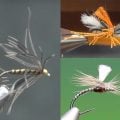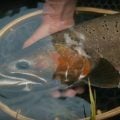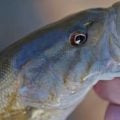How to Tie a Blue Quill Parachute
Producer: Tim Flagler
Before the actual tying starts, it’s a good idea to prep a few quills. These come from just below the eye on a large peacock feather. You can strip them with your fingernails, with a hobby knife, an eraser or chemically strip the whole eye at once, as I’ve done here. Anyway, I recommend placing whatever stripped quill you’re going to use into a warm water bath for at least ten minutes prior to tie-in, to make it more supple and less prone to splitting. Trust me, this is a step you don’t want to skip.
For a hook, I’m going to use a Lightning Strike DF1 in size 16. Begin by getting the hook firmly secured in the jaws of your tying vise.
For thread, I’ve loaded a bobbin with a spool of brown Veevus 16/0, as I want to keep bulk to a minimum. Get the thread started on the hook shank, leaving an eye-length-and-a-half space behind the back edge of the hook eye, and take a few wraps rearward before snipping off the excess tag. Continue taking thread wraps down the shank until your thread hangs at about its midpoint.
Dun hackle fibers are used for the tail of the fly. This particular cape has a beautiful kind of tan tint to it that I really like, and some natural variability and barring as well. For me, the buggier, the better. Good tailing fibers can be hard to find. I like to use the feathers from out at the edge of the skin, as they generally have longer, stiffer, straighter fibers.
Gently preen down a dozen or so fibers perpendicular to the stem and pinch them together to keep their tips aligned. Squeeze tight with your fingers then strip the stem away from the fibers. While keeping the tips aligned, pass the fibers to the fingers of your right hand, then measure to form a tail a shank plus a hook eye in length. Transfer that measurement rearward to the start of the hook bend and get hold of the fibers in the fingers of your left hand. Trim the excess curly butts off and place the fibers on top of the hook shank. Take thread wraps rearward, pulling the fibers up and towards you as you go. This will ensure they land on top of the hook shank as opposed to being pushed over to the far side. Wrap all the way back to the start of the hook bend, but no further. Relocate your tying thread back up the hook to a point about 1/4 of the way down the shank. This will be the location of the wing post.
Dyed calf body hair is used to form the wing post. Here, I’m going to use dark dun. Snip a small clump free from the hide. Clean out the butts then stack the clump really well. Remove the hair from the stacker with the tips pointing to the right, then get hold of the hair in the fingertips of your left hand. Measure to form a wing, and like the tail, make it a hook shank plus an eye in length. Transfer that measurement forward to over top of your tying thread and use a pinch wrap to begin securing the clump to the top of the hook shank. Take tight touching wraps rearward while bracing the calf hair so it doesn’t spin. Maintain your grip on the butt ends as you go. Lift the butt ends up and snip them off at a shallow angle. Continue taking thread wraps rearward. Ideally the snipped butt ends of the calf hair should create a nice gentle slope all the way down to the base of the tail. Return your thread forward to the wing post then pull the post back and make sure that it’s anchor point is still in the right place. Leave your tying thread just aft of the post.
Remove one of the stripped peacock quills from the warm water bath and dry it off well. Orient the quill so its darker edge is down and the thin tip points to the right. Snip the very thinnest part of the tip off then anchor the quill to the near side of the hook. End with your tying thread back where you started. Take touching wraps up the shank with the quill. I like to use my fingers rather than hackle pliers. When you reach your tying thread, use it to firmly anchor the quill then snip the excess off close.
Advance your thread forward to the wing post, then pull the hair back and crease it with your thumbnail. Take a few wraps in at the base of the hair to help prop it up. Preen the hair into a neat clump and start taking posting wraps, first up the hair for about 1/8” then back down. After posting, make sure to get a full thread wrap or two around just the hook shank to save your work.
Quill bodies are delicate and need to be reinforced. A couple drops of good old fashioned water base head cement are all that’s needed. Apply the cement completely around the body but keep the coating light. Once it sinks in and dries, it will greatly increase durability.
To hackle the fly, I’m going to choose a single feather from the same cape as I used for the tail. Before removing the feather from the cape, I’ll measure its fibers on a hackle gauge to make sure they’re of the correct size, here, a perfect size 16. Only then will I pluck the feather free from the skin. With the shiny side of the feather facing you, strip off all the lower webby fibers from both sides of the stem. Then, strip a half dozen or so more fibers from just the top side of the stem, like so. Now, flip the feather over so its dull side faces you. Place the feather against the near side of the hook and snip the excess stem off, leaving enough bare stem to go down the hook shank then up the post.
Take thread wraps to anchor the stem, first to the shank, up the post then back down. Once again, take a wrap or two around just the shank in front of the post to save your work.
Natural colored beaver fur dubbing is used to create the thorax of the fly. The smallest of pinches is all you need. Do remove any overly long guard hairs from the fine, fluffy underfur. Use the beaver fur to create a short, very slender dubbing noodle on your tying thread. Start taking wraps with the noodle so the dubbing begins right at the back edge of the hook eye. Continue taking wraps to cover up any tying indiscretions below, then end with your thread in front of the post, on the near side of the fly.
Using your favorite hackle pliers, get hold of the feather’s tip and manipulate it so that extra bit of stripped stem contacts the wing post first. This will ensure that the feather wraps correctly. Continue taking touching wraps with the feather down the post. When you reach the top of the thorax, take two or three flat wraps of tying thread to firmly anchor the feather’s tip to the post. Remove your hackle pliers then use the very tips of your tying scissors to trim the excess hackle off close.
Reach for your whip finish tool and use it to do a vertical whip finish right at the base of the post. Seat the knot well and snip or cut your tying thread free. There will invariably be a few fibers trapped on the far side of the fly. Simply snip anything pointing down, off close. A drop of head cement, here Sally Hansen Hard as Nails, applied to the base of the wing post will ensure nothing comes unraveled.
And that’s a nice svelte size 16, parachute-style Blue Quill. If you used water based head cement on the body of the fly, make sure to let it dry overnight before fishing the fly. It’ll be worth the wait.
How to Tie a Blood Knot Super Fast Using a Carabiner
How to Tie a Blue Quill Variant











